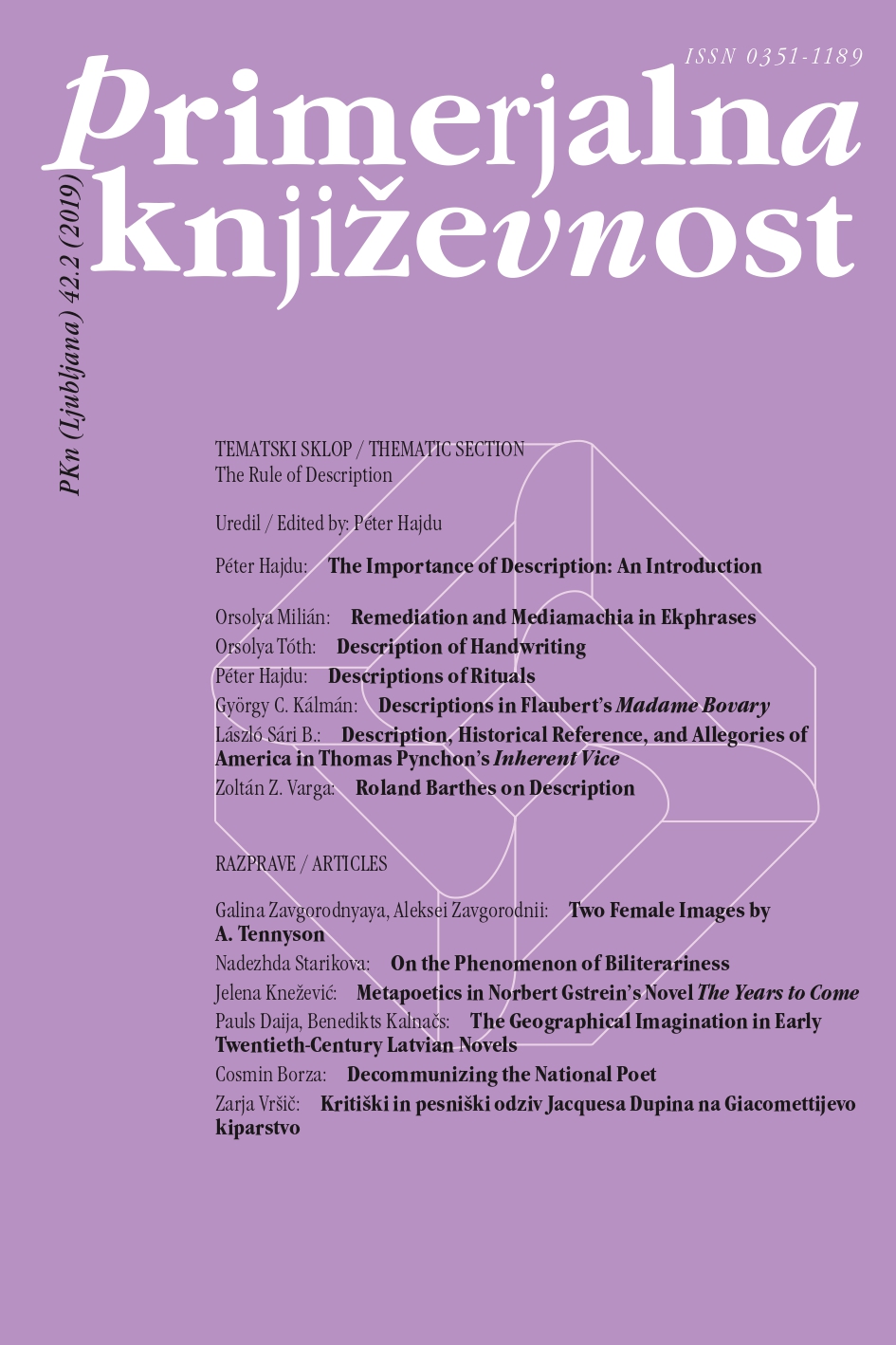Descriptions in Flaubert’s Madame Bovary
Keywords:
narratology, French literature, Flaubert, Gustave, Madame Bovary, narrative technique, description, realism, parodyAbstract
Although it is a common perception that Flaubert’s Madame Bovary employs a conventional set of procedures in order to balance story-telling and description, not only is the number of descriptions contained in this work surprisingly low but also these descriptions are rather peculiar and have a special function. This paper focuses on Flaubert’s descriptions regarding the cap of the young Bovary, Emma and Bovary’s wedding cake and the town hall of Yonville; all these are the emblems of bad taste, the philistine ideal of happiness and the artificial sublimeness of the public space. These descriptions raise further questions in connection to the narrator’s special point of view, their aims and position as well as the function of these segments. From a textual standpoint, these elements are also paralleled and partially interwoven with a kind of cataloging or listing type of text formation. I contend that they are in fact parodical in quality and that the end effects result in a mockery of the conventions of narration which were about to become established at the time: instead of being conventional, the descriptions of Madame Bovary are ironically counter-conventional.References
Amann, Elizabeth. Importing Madame Bovary. The Politics of Adultery. New York: Palgrave Macmillan, 2006.
Bernard, Claudie. “Monsieur Bovary.” French Forum 10.3 (1985): 3.307–324.
Begam, Richard and Soderholm, James. “Flaubert’s hat trick, or The pleasures of banality.” Platonic Occasions: Dialogues on Literature, Art and Culture. Eds. Richard Begam and James Soderholm. Stockholm: Stockholm University Press, 2015. 3–17.
Collas, Ion K. Madame Bovary. A Psychoanalytical Reading. Geneva: Librairie Droz, 1985.
Flaubert, Gustave. Madame Bovary. Moeurs de province. Roman. La Bibliothèque électronique du Québec, Collection À tous les vents, Volume 715, version 2.01. https://beq.ebooksgratuits.com/vents/Flaubert-Bovary.pdf.
– – –. Madame Bovary. Tran. Eleanor Marx-Aveling. http://www.gutenberg.org/files/2413/2413-h/2413-h.htm#link2HCH0001.
Genette, Gérard. Narrative Discourse. An Essay in Method. Tran. Jane E. Lewin. Ithaca: Cornell University Press, 1980.
Horatius. Opera. Ed. Stephanus Borzsák. Leipzig: Teubner, 1984.
Hajdu, Péter. “The Collective in the Hungarian Narrative Tradition and Narrative Studies.” Neohelicon 45.2 (2019): 431–443.
Kalka, Joachim. Gaslights. Lantern Slides from the Nineteenth Century. New York: New York Review Books, 2017.
Lőrinszky, Ildikó, and Péter Ádám. “Le chapeau escamoté.” Cahiers d’Études Hongroises 11 (2003): 177–181.
Nabokov, Vladimir. Lectures on Literature. Vol. 1. New York: Harcourt Brace Jovanovich, 1980.
Porter, Laurence M., and Eugene F. Gray. Gustave Flaubert’s Madame Bovary. A Reference Guide. Westport: Greenwood Publishing Group, 2002.
Privat, Jean-Marie. “Ethnocritique d’une fameuse casquette.” Litterature et anthropologie 82 (2013): 91–102.
Rőhrig, Eszter. Emma Bovary, “másik világa”-nak elbeszélői értékelései Flaubert Bovaryné című regényében. PhD Thesis, Debrecen University, 2010. https://dea.lib.unideb.hu/dea/bitstream/handle/2437/99771/01_doktori_t.pdf?sequence=5&isAllowed=y.
Sartre, Jean-Paul. L’Idiot de la famille. Paris: Gallimard, 1983.


